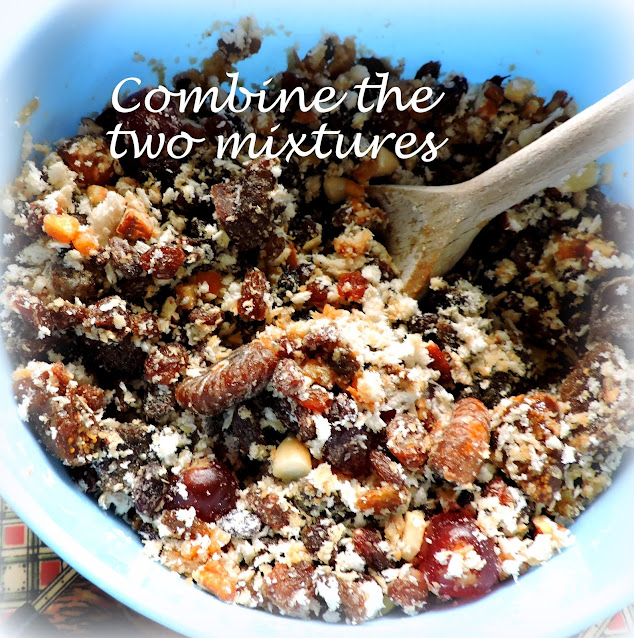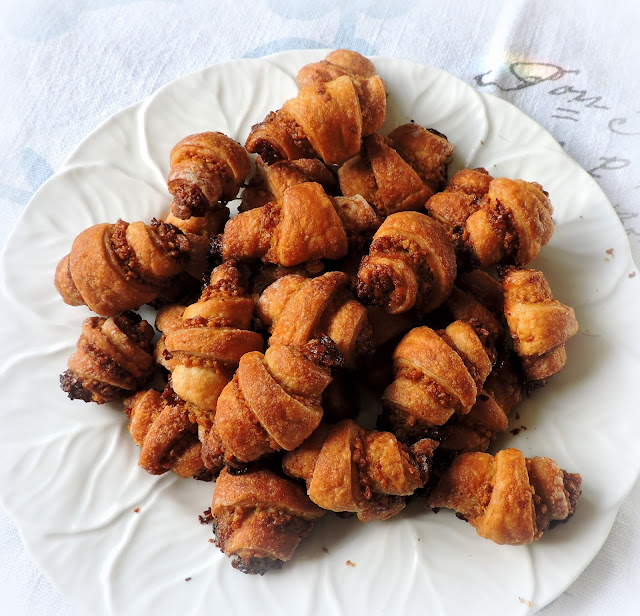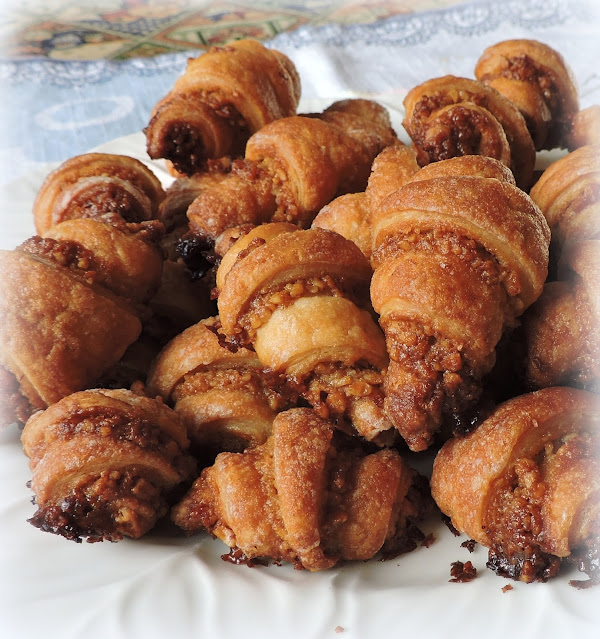I thought this weekend I would make our Christmas pudding for this Christmas and get it done and put away so that it is nicely ripened for the big day. Christmas puddings are a really big deal over here in the UK.
Back home we might have had a
Carrot Pudding with Brown Sugar Sauce, but we didn't really do Christmas Puddings as such. The carrot pudding would usually have to be made on the day, although admittedly, my MIL used to make it and freeze it, and then just reheat it in the top of a double boiler.
Christmas Puddings are a very traditional thing here in the UK. Christmas (or Plum) Pudding is the traditional end to the British Christmas dinner. But what we think of as Christmas Pudding, is not what it was originally like!
Christmas pudding originated as a 14th century porridge called 'frumenty' that was made of beef and mutton with raisins, currants, prunes, wines and spices. This was quite liquidy, would need to be eaten with a spoon like a soup, and would have been a fasting meal during the preparations up to Christmas.
By 1595, frumenty was slowly changing into a plum pudding, having been
thickened with eggs, breadcrumbs, dried fruit and given more flavor with
the addition of beer and spirits. It became the customary Christmas
dessert around 1650, but in 1664 the Puritans banned it as a bad custom. (Those old Puritans were a bunch of party-poopers!)
In 1714, King George I re-established it as part of the Christmas meal,
having tasted and enjoyed Plum Pudding, and by Victorian times, Christmas
Puddings had changed into something very similar to the ones which are prepared and eaten
today.
The Plum pudding is a national symbol – It does not represent a class or
caste, but the bulk of the English nation. There is not a man, woman or
child raised above what the French would call proletaires that does not
expect a taste of plum pudding of some sort or another on Christmas
Day.
~London Illustrated News, 1850
Traditionally a Christmas Pudding is prepared on the last Sunday before Lent, which is lovingly referred to as "Stir Up Sunday." Stir-up-Sunday is usually a family affair.
Each family member is supposed to stir the mixture from East to West to honour the journey of the Magi. This ritual is also thought to bring the family luck and prosperity in the coming year.
At one time it was also customary to hide a number of small trinkets in the mixture, a bit like the twelfth night cake. These charms often included a silver coin (wealth), and a ring (future marriage).
Woe betide the guest who stumbled across a thimble in their serving. A future of Spinsterhood was a cert for them! Nowadays this generally isn't done, although Todd does remember his mom putting coins into theirs.
I am doing mine a bit earlier this year so that I can present you a tutorial on it and give you time to get in any necessary ingredients, etc. "Stir-up-Sunday" this year will be the 19th November.
The fruit mixture of the pudding is a mix of dried figs, currants, raisins, golden raisins, cherries and candied ginger.
All are mixed together in a bowl the night before you go to make your pudding and a portion of brandy is poured over top and the fruit left to macerate in this overnight on the counter top.
A clean towel over top to keep it safe from dust and insects. If you don't like to use alcohol, you can use orange juice in an equivalent amount.
The next day softened butter is creamed together with soft light brown sugar, orange zest, ground cinnamon and ground mixed spice.
You can easily make your own mixed spice: Combine 1 TBS ground cinnamon,
1 tsp each of ground coriander and nutmeg, 1/2 tsp of ground ginger,
1/4 tsp each of ground cloves and all spice. Mix well and store in an
airtight container out of the light for up to 6 months.
An egg also gets beaten into this, a bit at a time so it doesn't curdle.
Fresh soft white bread crumbs are mixed with chopped blanched almonds and toasted pecan nuts.
Two kinds of flour are stirred into this mix of nuts, bread crumbs and spice. Plain flour and self raising flour.
You can make your own self raising flour by adding 1 1/2 tsp of baking powder and 1/4 tsp of salt to every cup of plain flour.
You then mix the macerated fruit together with the flour/nut/bread crumb/spice mixture.
This mixture then gets added and stirred into the creamed mixture to combine. Make sure everyone gives it a stir and makes a wish.
Don't forget East to West, just don't ask me which is which, lol! If you are putting trinkets in this is when you would do it.
I would wrap them in cling film first or waxed paper, and don't forget to warn any guests that they are there when it comes to eating!
The pudding basin is prepared by generously brushing it with melted butter and placing a round of baking paper in the bottom.
Pack the pudding mixture into the prepared pudding basin, smoothing the top out with the back of a wooden spoon.
Once you've done this tap the bottom of the basin on the countertop a few times to settle and work out any air holes.
This is the most complicated part of the pudding. Creating the lid to wrap it in. Lay a large piece of foil on the table, and top it with an equal sized piece of baking paper.
You then make a pleat in the paper, bearing in mind that the baking paper will be the side against the pudding. Butter the paper.
I fold them in half with the paper on the inside, and then, from about 2 inches down, I fold them back on themselves.
It should look like this on the paper side, and like the top picture from the foil side.
Wrap this over the top of your pudding basin, leaving plenty of room for expansion, paper side towards the pudding. Tie it tightly onto the bowl with some kitchen twine, bakers twine or even using a rubber band.
I use bakers twine and using a generous length, after I have knotted it, I fashion a handle with the excess that I bring back over the top and secure on the opposite side. This makes it easier to lift out of the pan when its done.
Trim off the excess paper and foil so it looks nice and neat.
You will need a large saucepan that is large enough to hold your pudding basin, with a tight fitting lid.
If you have a small trivet you can place it in the bottom of the pan, or you can do like me and fashion your own using a canning jar ring and some balls of foil.
The pudding basin gets set on top of this and boiling water gets poured down inside the saucepan just to come up 3/4 of the way of the sides of the pudding basin.
Tightly covered, the saucepan is then put on a low heat and the pudding simmers away for about 4 1/2 hours. Make sure you check it periodically and top it up with more boiling water as needed. You don't want it boiling dry.
At the end of that time, remove the pudding basin and let it cool on a rack overnight. Once it is cold you can remove the old wrappings and wrap it with clean new wrappings and then store it in a dark, cool and dry place until Christmas Day! Instructions for re-heating are in the recipe.
And there you have it . . . . Christmas Pudding!

*Christmas Pudding*
Serves 6 to 7
It
wouldn't be Christmas without one. I try to make mine in November so
that it is nice and matured by the time Christmas rolls around.
125g dried figs, quartered (3/4 cup)
100g raisins (2/3 cup)
75g golden raisins (scant half cup)
75g dried currants (scant half cup)
50g glace cherries (1/3 cup)
65g candied ginger (scant half cup)
100 ml brandy (6 1/2 TBS)
125g butter, softened (1/2 cup)
140g soft light brown sugar (2/3 cup)
1 tsp freshly grated orange zest
1 large free range egg
25g blanched almonds chopped roughly (3 TBS)
25g toasted pecans, chopped roughly (3 TBS)
90g soft white bread crumbs (1 generous cup)
30g plain flour (1/4 cup)
15g self raising flour (1/8 cup)
1/2 tsp each ground mixed spice and ground cinnamon
pinch salt
Mix
all of the dried fruit together in a bowl. Add the brandy and stir,
mixing well together. Cover with a clean tea towel and leave on the
counter overnight to macerate.
The next day bruht a 1 litre
pudding basin (5 cup) well with melted butter and place a round of
baking paper in the bottom. Set aside.
Cream the butter,
sugar and orange zest together until light and fluffy in a large bowl.
Beat in the egg. Stir together both flours, nuts, spices and bread
crumbs. Add the macerated fruit and stir together to combine. Stir this
mixture into the creamed mixture combining well together. Spoon into
the prepared pudding basin, pressing it down to compact, smoothing the
top withthe back of a wooden spoon. Tap on the counter several times to
remove any air holes.
Place a large sheet of tinfoil on
the counter. Top it with an equal sized piece of baking paper. Butter
the paper. Make a pleat in the centre of both sheets together. Wrap
them over top of the pudding, leaving room for expansion. Secure
tightly with either a rubber band or kitchen string.
Place a
small heat proof trivet in the bottom of a large saucepan (with a tight
fitting lid). Lower the pudding into the saucepan, placing it on top of
the trivet. Fill the saucepan with enough boiling water to come 3/4 of
the way up the sides of the pudding bowl. Cover tightly and simmer over
low heat for 4 to 4 1/2 hours, topping up as necessary with boiling
water. Do NOT let it boil dry.
At the end of that time,
carefully fremove it from the saucepan. Leave to cool overnight. The
next day remove and discard the messy wrappings and rewrap in some clean
baking paper, foil and string. Store in a cool dark and dry place
until Christmas.
On Christmas Day, boil or oven steam (in
the container) for about an hour until heated through. Unwrap and turn
out onto a serving plate. Serve with your favourite sauces.
(You can serve it with Brandy Butter, Brown Sugar Sauce, Cream, Custard, etc.)
This was fun. I hope you will give it a go and make your own Christmas Pudding this year. It's really not that hard to do, and when you make your own, you know exactly what has gone into it! Bon Appetite!




















































